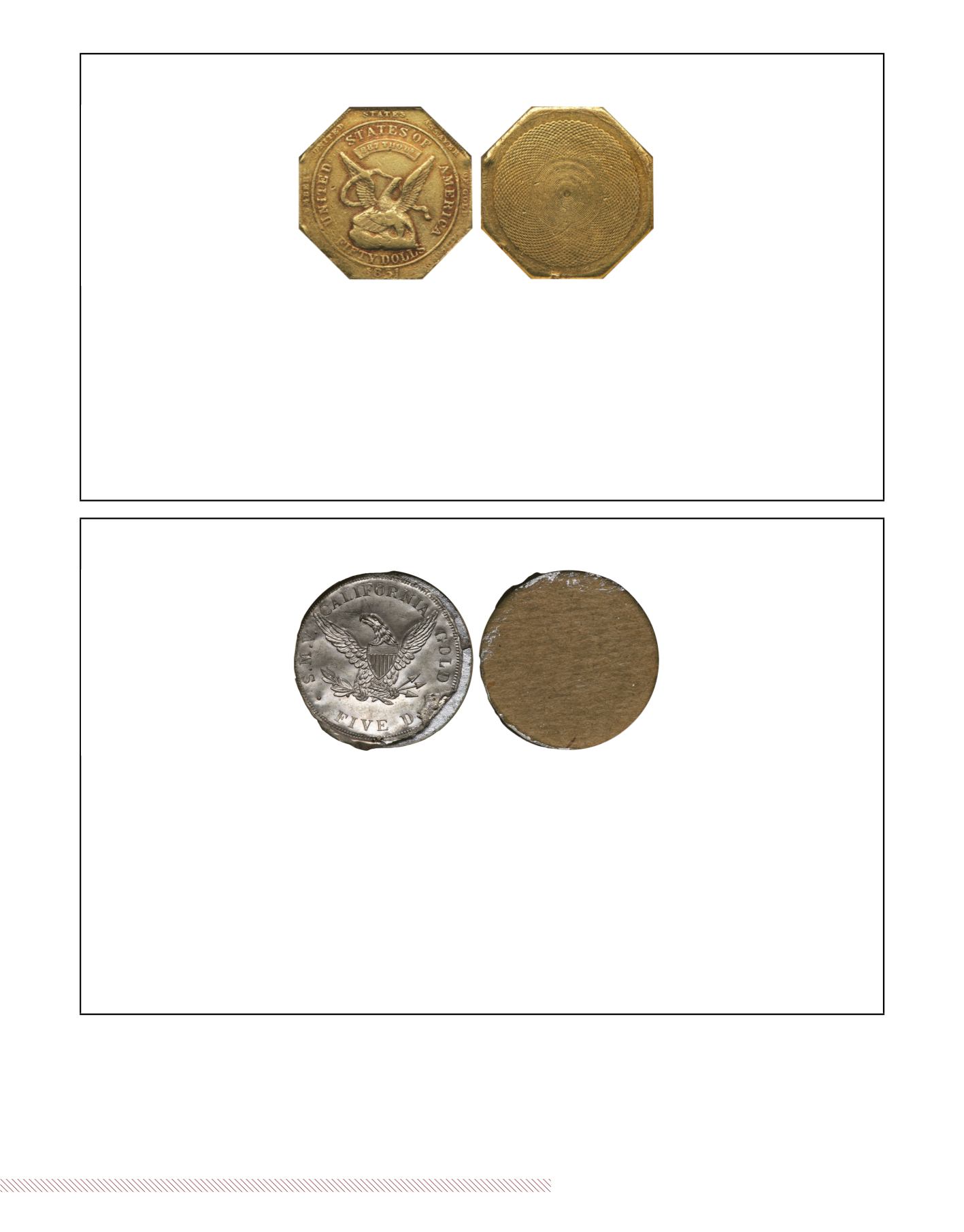
1
357
bid online at
(800) 978-COIN (2646)
|
Territorial
Gold Coins
H
ISTORICAL
1851 U.S. A
SSAY
O
FFICE
$50 S
LUG
2209
1851 U.S. Assay Office $50 "Slug", 887 THOUS. Reeded Edge. K-6, Rarity 4.
NGC graded AU-55.
CAC APPROVED.
The U.S.
Assay Office would produce what became the highest denomination U.S. gold coin to circulate -- octagonal-shaped $50 gold coin-ingots,
often referred to as "Slugs." On the reverse, the design appears as a series of concentric circles in the center, surrounded by overlapping lines
or perhaps a better way of putting it is a series of wavy, concentric circles (found on the reeded edge slugs). These concentric circular lines
are known to mechanics as "engine turning," the design is similar to the web-like engraving in the vignettes on paper money or on watch-
cases, and unique to Territorial Gold struck at the Assay Office of Gold in the early years of the Gold Rush.
This is a visually impressive slug, as are they all, with rich green-gold coloration, and an accumulation of red toning in the recesses of the
design, especially on the obverse. The remaining details are about average for the type, the obverse peripheral inscription discernible,
although weak in certain areas, and the eagle well detailed over all but the most central features. A few scattered abrasions and a couple of
minor rim bruises are noted, but we stress that none of these distractions are overly out-of-context for a lightly circulated gold coin of this
size. A historically significant issue that enjoys high collector demand in today's hobby.
Pop 12; 28 finer
. (
PCGS # 10214
)
Estimated Value ................................................................................................................................................................... $60,000-UP
1850 D
UBOSQ
AND
C
O
D
IE
T
RIAL
"S
PLASHER
" K-3
A
, MS-64
Enlargement
2210
1850 $5 Dubosq and Co Die Trail "Splasher" ANACS MS-64. Kagin 3a, Rarity 8.
In 1850, Theodore Dubosq and Co. struck five and
ten dollar gold coins in San Francisco. Previously, he had been a jeweler in Philadelphia, but decided to move West in 1849 to also profit from
the results of the California Gold Rush. According to Breen (1988), only three five dollar gold pieces remain of the approximately 10,000
pieces originally struck, the remainder was apparently melted, a similar fate came to the tens, however, it is now estimated 8 to 10 of that
denomination are now known. One of the fives is in the Smithsonian, one is in the Omaha City Library/Byron Reed Collection, and one is a
plugged coin that has not been seen since 1951.
This die trial piece, also called a "splasher" is the closest one can come to owning a Dubosq half eagle. Since it is a Territorial Gold pattern, it
is also extremely rare in its own right. This is the reverse-only (uniface) splasher struck in white metal. It exhibits a medium gray finish with a
somewhat reflective nature. The thin white metal on which this was struck exhibits a concave appearance and it seems to have remnants of
paper on the back. Recent research has indicated the engraver of this reverse die might have been James B. Longacre. A number of years
ago, patterns were found in his estate and the inventory might have included several Dubosq "splashers." Close inspection shows a remark-
able similarity between the eagle on this die trial pattern and federal half eagles of the time. An interesting piece of Western Americana, this
die trail is of the greatest importance to collectors of territorial gold.
Estimated Value ................................................................................................................................................................... $12,500-UP


